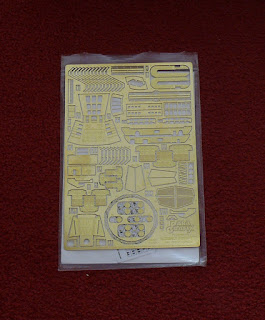Thursday 7 September 2017
NCC 1701
Although I wouldn't presume it's of interest to the majority of my readers, I enjoy making models of things. Just as I can't walk past a record shop (and can't go in one without making a purchase) so I'm a sucker for any model shop/hobby store type establishment. Give me a craft knife, a cutting board, some glue and a CD or two to while away the hours and I couldn't be happier. I suppose it goes back to childhood fridays after school, when a trip to Bridgend market would often see me returning home with the treat of an Airfix kit ... usually reduced to a sticky, finger-printed blob by the end of the evening. Yes, we really knew how to live it up in the old days.
During a trip to Manchester about seven years ago, I snuck off for an hour or two and returned to the hotel with a large and expensive box containing a plastic kit of the USS Enterprise.
As I've mentioned before, I have a particular "thing" for the Enterprise. It makes no sense from an astronautics/physics point of view (what the hell are those warp engines doing so far from the nominal center of gravity?) but it sure does look cool, and this lifelong love affair was firmly cemented by about the age of seven, when I had the Aurora kit of the original version of the ship. I loved everything about the original Enterprise and was heartbroken when one of my warp pylons snapped off (it could nae take the strain, clearly). Later I had the Aurora kit of the Klingon cruiser which suffered a similarly terminal neck-break. Clearly I wasn't destined to possess a Star Trek spaceship for any length of time.
Decades later, and that itch hadn't been adequately scratched, as I still felt the need to own an Enterprise. If I was going to have one, I reasoned, it might as well be big ... and the Polar Lights model, shown above, is certainly on the large side, being 35 inches long when assembled. At the time of purchase, the only kit offered was the one for the "refit" version as featured in the films, and truth to tell I still preferred the clean, art-deco lines of the original ship. Still, it was an Enterprise, wasn't it?
Early on in the build, I decided to light the model from inside. This entailed adding a lot of LEDs and black light-masking, with silver foil to help the light bounce around inside.
In the end the model used about 50 LEDS of various colours, none of which can ever be replaced.
I also added some etched details, including tiny crew figures, barely visible through some of the windows:
I worked on the model during odd evenings over the last few years, but it was only this year that progress really came together. Most of the work involved fitting LEDS, and then laboriously ensuring that no light was spilling out where it shouldn't. For instance, here's the saucer section, fixed together but still being tested and light-blocked:
Finally, the various parts of the model were ready to be assembled and painted. One major step is to cover almost every square inch of the thing with decals, simulating the complex patchwork of shades on the film model. Adding these was very long-winded, but an oddly therapeutic and satisfying process. Finally, the decals for the name, registry number, and so on, were added over the top - literally hundreds of these, since every phaser port, photon torpedo launcher, airlock, etc, has a decal.
At last the model was ready for final finishing, and here it is from another couple of angles compared to the shot at the top of the page.
The biggest pay-off, for me, is when the lights are on. Here's a shot of the overall ship, and a close-up of the shuttle bay.
And the upshot of all this work is that I've formed a very strong appreciation for the refit Enterprise ... to the point where I think I now prefer it to the original version. I think it's a truly beautiful and iconic design, one of the great televisual/cinematic starships. Never mind that it makes no sense!
I hope some of you enjoyed this somewhat off-beat interlude.
Sunday 3 September 2017
Subscribe to:
Posts (Atom)










